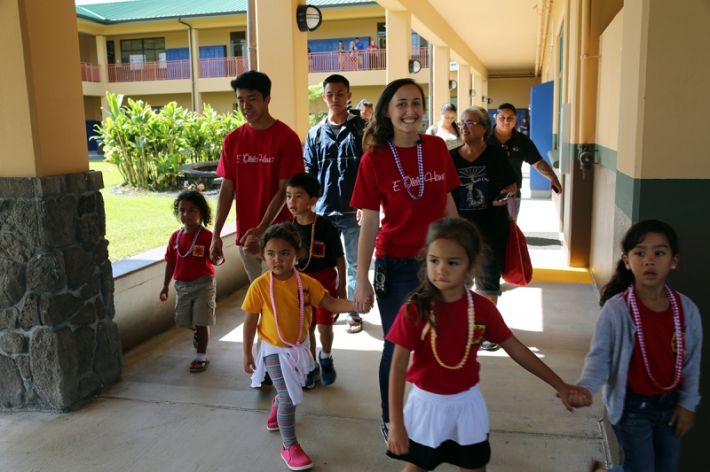When KS Hawaiʻi senior Kaluhikaua Kaʻapana was considering her options for her senior legacy project, she looked to her two passions: education and Hawaiian language.
Every KS Hawaiʻi student is required to complete a senior project in order to graduate.
In building hers, she met with her Hawaiian language kumu Pomaikaʻi Baptista who encouraged her to take a closer look at KS’ Strategic Plan 2020; KS’ WEO (working exit outcomes that define knowledge, skills, and values all KS students must master); and content teaching standards for preschool and connect them to her project.
“Becoming a teacher was always something I wanted to do, but recently I discovered that what I really want to do is work in the immersion schools,”said Kaʻapana.
Kaʻapana decided to create an event called “Lā Pilina” which would bring preschool students from Pūnana Leo o Hilo to the Keaʻau campus for a day of learning activities and fellowship with students in the Hawaiian language five class.
“She decided to incorporate Goal 1 in engaging with our local Hawaiian immersion schools and teachers, as well as Goal 3, in fostering our Hawaiian language identity through use of the Hawaiian language,” shared Baptista.
“Throughout the process I’ve seen the importance of SP2020 and how what we’re working toward will benefit the school in the future as well as other schools like Pūnana Leo because we built that pilina with them through this,” said Kaʻapana.
The event was truly a partnership with both sides rewarded for coming together and participating.
“It’s an opportunity for us all to deepen our relationships, and enhance our language skills,” said Kealoha Reff, kumu alakaʻi (lead teacher) for Pūnana Leo o Hilo.
“And you could see it happening. As they were teaching, they shared their ʻike with the children.
“Hawaiian language is at the core of everything we do at Pūnana Leo o Hilo. So when we came here, it was great to show our children that our language also lives in other spaces, like here at Kamehameha Schools.”
The entire day was planned and executed by students in the Hawaiian language 5 class.
After being welcomed to campus, KS students led the preschoolers on a campus tour, followed by breaking up into four activity groups. One group would learn hula and have a chance to dance. Another taught about animals with a reading activity followed by an exploration of the on-campus mala (garden) to see the animals there and create a hana noʻeau (craft) chicken mask. Another group hosted a coloring activity to teach a lesson about colors. Finally, students in the last group could learn how to kuʻi kalo (pound taro) to create kuʻi ʻai.
“This was a great chance for her to experience the varying responsibilities of a teacher,” said Baptista about Kaʻapana.
Next year, the Hilo girl plans to head to the University of Hawaiʻi at Mānoa and double major in both education and Hawaiian language. She does so with the intention of returning home and pursuing a career as a Hawaiian immersion teacher.
“I think that the immersion schools is a place where they need teachers and support so I see myself working there with the elementary,” said Kaʻapana.
Her experience over her high school career working and attending a number of cultural events influenced her decision to pursue this path.
“We’re still trying to revive our culture and our language and I think that it’s important to instill Hawaiian values into the younger generations, so I kind of felt that was my kuleana.”
For other students the experience was eye opening, changing a career path for one and completely validating a desire to continue an education path for another.
For Kaʻapana, she remains steadfast in her desire to serve her community as an immersion teacher in the future. She also hopes the experience will help to validate the need for more Hawaiian language resources at Kamehameha Schools.
“There should be more focus and support. We’ve gotten a lot of support but there could have been more people on board with it,” shared Kaʻapana.
“It’s really important to know the language. Being a part of events like ʻAha Makahiki, it opened my eyes to see it’s a part of our cultural identity. We know who we are and we know that we’re grounded here. After I graduate, I know that I won’t be wondering who I want to be in the world because I know that I am a Hawaiian and it is my kuleana to perpetuate the culture.”
This story is part of “I Mua Kamehameha,” an ongoing effort to celebrate the excellence of KS campus and community education programs. Inspirational stories will be shared throughout the year about KS servant leaders who are improving the lives of KS haumāna and contributing to a thriving Lāhui.

Lā Pilina was senior Kaluhi Kaʻapana's (center) senior legacy project.

Following the learning activities, the groups came together for some fun games, like kickball, on the field.

Groups exchange oli and come together in mele at the start of the day.

KSH students lead Pūnana Leo o Hilo preschoolers on a tour of the Keaʻau campus.

Coloring activity group learns more about colors and their names.

Kaʻapana looks on at the hula activity group, teaching a hula to the song Hōlei.

The kalo activity group practiced how to kuʻi ʻai and learned more about kalo.

Students take a look at the mala and the chickens in the farm area.

After touring the farm area, students create a hana noʻeau (craft) representing one of the animals they learned about.
Related stories
TAGS
keaau campus,
ks hawaii,
sp 2020,
strategic plan,
hawaiian language,
hawaiian culture,
senior legacy projects,
sp2020
CATEGORIES
Kaipuolono Article, I Mua Kamehameha, Newsroom, Campus Programs, Hawaii
Print with photos
Print text only










